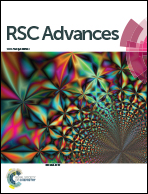Photocatalytic dye-degradation activity of nano-crystalline Ti1−xMxO2−δ (M =Ag, Pd, Fe, Ni and x = 0, 0.01) for water pollution abatement
Abstract
Nanocrystalline metal-ion (M = Fe, Ni, Ag, and Pd) doped and undoped anatase-TiO2 powders were prepared using a solution combustion method. The photocatalytic degradation of different dyes such as methylene blue (MB), rhodamine B (RB), rhodamine B base (RBB), and thionine acetate (TA) was investigated under UV exposure. The degradation rate of the dyes were found to be better in the case of Ag+ and Pd2+ doped TiO2, whereas Fe3+ and Ni2+ doped TiO2 showed lower photocatalytic activity compared to undoped TiO2 nanoparticles. Combustion synthesized catalysts exhibited much better activity compared to the commercial Degussa P25 (75% anatase + 25% rutile) TiO2 photocatalyst. The intermediate states created in the band gap of the TiO2 photocatalyst due to doping of first row transition metal ions (such as Fe3+ and Ni2+) into the TiO2 lattice act as recombination centres and the electrons present in the d-orbital quench the photogenerated holes by indirect recombination, hence increasing e−–h+ recombination rates. As a result, a decrease in the photocatalytic activity of TiO2 doped with first row transition metal ions is observed. However, in the case of noble metal ions (such as Ag+ and Pd2+) in TiO2, photoreduction of Ag+ and Pd2+ ions occurs upon UV irradiation, hence the noble metal-ions act as electron scavengers. Consequently, the lifetime of the holes (h+) increases and hence higher photocatalytic oxidation activity of the dyes is observed. A novel strategy of electron scavenging is envisaged here to develop Ag+ and Pd2+ doped TiO2 to increase the photocatalytic oxidation of organic dyes for the development of better water pollution abatement catalysts. Redox-pair stabilization in the TiO2 lattice similar to photo-chromic glasses play a defining role in enhancing the photocatalytic activity of the catalyst and is a key finding for the development of superior photocatalysts. With the help of UV-vis and fluorescence spectroscopy, the mechanisms of the superior oxidation activity of Pd2+ and Ag+ doped TiO2 nanoparticles are explained.



 Please wait while we load your content...
Please wait while we load your content...